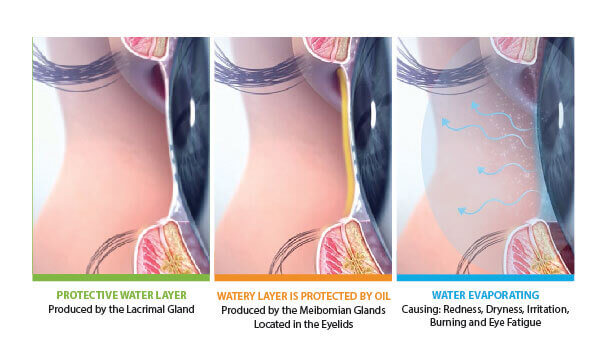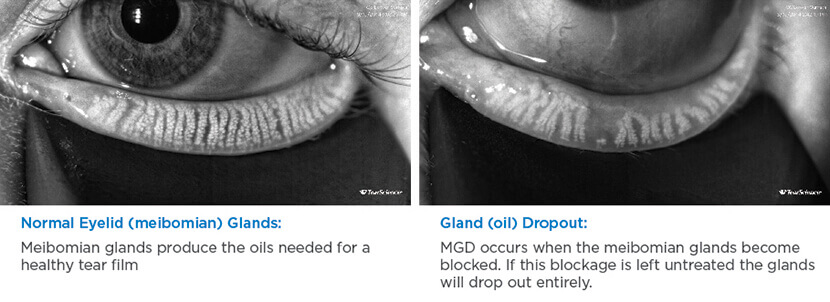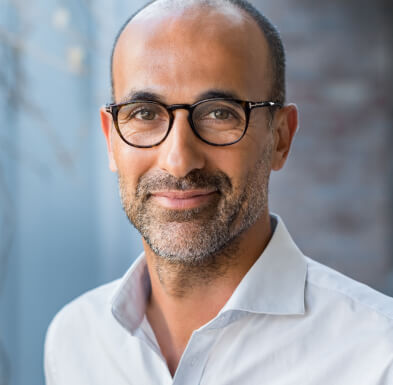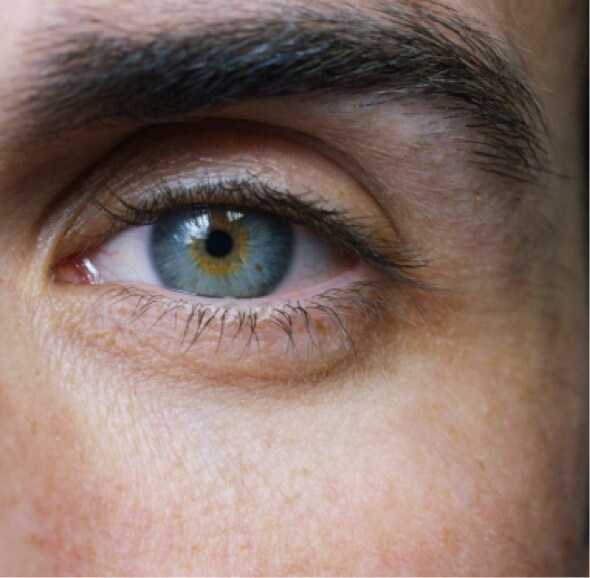IPL Treatment / Dry Eye
It’s time to change your outlook on dry eye.
There are roughly 30 million people in the United States and over 300 million worldwide who have been diagnosed with dry eye. Most have learned to live with eye discomfort and have become dependent on drops or other treatment methods that only offer temporary relief. This has been due to a lack of understanding that the root cause of most dry eye (86%) is now known to be a chronic and progressive condition, Meibomian Gland Dysfunction or MGD.

MGD occurs when there is a compromise to the function and/or structure of the meibomian glands in the eyelids that produce the protective oily layer of the tear film. These glands can become blocked over time and can no longer produce oils needed for healthy tears. This blockage results in rapid evaporation of your tears and can lead to irritation, discomfort and if not treated, gland dropout.
MGD Identification
A series of evaluations will be performed to determine if you have MGD. This can include a LipiView® tear film and gland imaging and a meibomian gland evaluation. Knowing what is causing your dry eye will help your doctor determine the best treatment option.

Now, with the breakthrough Intense Pulsed Light (IPL)® technology, it’s possible to directly treat the root cause of Dry Eyes and MGD.
Intense Pulsed Light
While there are many treatment options available for dry eye, one innovative approach that has gained popularity in recent years is intense pulsed light (IPL) therapy. At Eye Care Associates of New Jersey, we are proud to offer this treatment to those struggling with dry eye symptoms.
What is Intense Pulsed Light (IPL)?
Intense Pulsed Light (IPL) is an FDA-approved non-invasive treatment that can help manage dry eye syndrome and reduce dry eye symptoms. By applying controlled pulses of light to the skin around the eyes, IPL can stimulate the meibomian glands, which are responsible for producing the oily layer of the tear film.
Dysfunction of these glands is a common cause of dry eye. IPL helps to unclog the glands, allowing them to release oils more effectively, which can improve tear quality and reduce inflammation.
The treatment typically requires multiple sessions for the best results. While there may be some temporary side effects, IPL offers a safe and effective option for those seeking relief from dry eye symptoms.
How Does IPL Help Treat Dry Eye?

IPL helps treat dry eye by targeting a root cause of the condition, Meibomian Gland Dysfunction, sometimes called MGD. Meibomian glands are tiny oil glands located along the edges of the eyelids.
They produce the oily layer of the tear film, which helps prevent tear evaporation and maintains eye moisture. In meibomian gland dysfunction, these glands become clogged or inflamed, leading to reduced oil production and poor tear quality.
IPL can help unclog these glands so that the oil can help lubricate the eye once again. IPL can help treat dry eye by:
Warming the Meibomian Glands
The heat generated by IPL liquefies the hardened oils, unclogging the glands, allowing it to flow more freely.
Reducing Inflammation
IPL has anti-inflammatory properties that can help reduce inflammation in the eyelids and meibomian glands.
Reducing Bacteria
The light energy from IPL can help reduce the presence of bacteria on the eyelids, which can contribute to inflammation and MGD.
The best way to know if IPL might be right for you is to schedule an appointment at Eye Care Associates of New Jersey.
What Happens During an IPL Session?
When you arrive for your IPL session, you’ll be guided to a comfortable reclining chair. To ensure your safety and comfort, protective shields or pads will be placed over your eyes, and a soothing, cool gel will be applied to the treatment area, allowing for optimal light transmission.
Your IPL specialist will gently position the IPL device on your skin, targeting the cheeks, nose, and lower eyelids. As the light pulses are administered, you may experience a gentle warming sensation or a slight snapping feeling.
Most people find the IPL treatment to be generally comfortable. Following the IPL procedure, your specialist may perform a manual expression of the meibomian glands to ensure any remaining blockages are cleared.
From start to finish, the entire session usually lasts between fifteen to thirty minutes.
How Long Do The Results of an IPL Treatment Last?
The results of an IPL treatment for dry eye can last several months, depending on each person and the severity of the condition. However, the effects may wear off over time, and the meibomian glands can become clogged again.
To maintain the benefits, it’s often recommended to have multiple sessions every couple of months. The frequency of maintenance treatments will vary from person to person based on their specific needs and how well they respond to the initial IPL session.
Do you want to learn if IPL might be able to help your dry eye symptoms? Schedule an appointment at Eye Care Associates of New Jersey in Glen Rock, NJ, today!
Dry Eye Glen Rock, Fair Lawn, Bergen County, NJ
Click here to schedule a Dry Eye appointment today!









